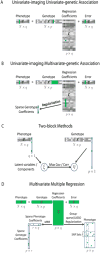Genetics of the connectome
- PMID: 23707675
- PMCID: PMC3905600
- DOI: 10.1016/j.neuroimage.2013.05.013
Genetics of the connectome
Abstract
Connectome genetics attempts to discover how genetic factors affect brain connectivity. Here we review a variety of genetic analysis methods--such as genome-wide association studies (GWAS), linkage and candidate gene studies--that have been fruitfully adapted to imaging data to implicate specific variants in the genome for brain-related traits. Studies that emphasized the genetic influences on brain connectivity. Some of these analyses of brain integrity and connectivity using diffusion MRI, and others have mapped genetic effects on functional networks using resting state functional MRI. Connectome-wide genome-wide scans have also been conducted, and we review the multivariate methods required to handle the extremely high dimension of the genomic and network data. We also review some consortium efforts, such as ENIGMA, that offer the power to detect robust common genetic associations using phenotypic harmonization procedures and meta-analysis. Current work on connectome genetics is advancing on many fronts and promises to shed light on how disease risk genes affect the brain. It is already discovering new genetic loci and even entire genetic networks that affect brain organization and connectivity.
Copyright © 2013 Elsevier Inc. All rights reserved.
Figures
References
-
- Anticevic A, Van Snellenberg JX, Barch DM. Neurobiology of emotional dysfunction in schizophrenia: new directions revealed through metaanalyses. BP. 2012;71:e23–24. author reply e25. - PubMed
-
- Bassett DS, Brown JA, Deshpande V, Carlson JM, Grafton ST. Conserved and variable architecture of human white matter connectivity. Neuroimage. 2011;54:1262–1279. - PubMed
-
- Benjamini Y, Hochberg Y. Controlling the false discovery rate - a practical and powerful approach to multiple testing. J Roy Stat Soc B Met. 1995;57:289–300.
-
- Blangero J. Localization and identification of human quantitative trait loci: king harvest has surely come. Current opinion in genetics & development. 2004;14:233–240. - PubMed
-
- Blokland GA, de Zubicaray GI, McMahon KL, Wright MJ. Genetic and environmental influences on neuroimaging phenotypes: a meta-analytical perspective on twin imaging studies. Twin research and human genetics : the official journal of the International Society for Twin Studies. 2012;15:351–371. - PMC - PubMed
Publication types
MeSH terms
Grants and funding
- R56 MH097940/MH/NIMH NIH HHS/United States
- R01 EB015611-01/EB/NIBIB NIH HHS/United States
- R01 MH078111/MH/NIMH NIH HHS/United States
- U54 MH091657/MH/NIMH NIH HHS/United States
- R01 MH089722/MH/NIMH NIH HHS/United States
- R01 MH078143/MH/NIMH NIH HHS/United States
- R01 MH083824/MH/NIMH NIH HHS/United States
- R01 MH080912/MH/NIMH NIH HHS/United States
- P41 EB015922/EB/NIBIB NIH HHS/United States
- R01 HL113323/HL/NHLBI NIH HHS/United States
- R01 EB015611/EB/NIBIB NIH HHS/United States
- R01 AG040060/AG/NIA NIH HHS/United States
- R01 EB008432/EB/NIBIB NIH HHS/United States
- R01 NS080655,/NS/NINDS NIH HHS/United States
- R01 HD050735/HD/NICHD NIH HHS/United States
- R01 EB008432/EB/NIBIB NIH HHS/United States
- R01 HD050735/HD/NICHD NIH HHS/United States
- R01 MH097940/MH/NIMH NIH HHS/United States
- R01 NS080655/NS/NINDS NIH HHS/United States
- U54MH091657-03/MH/NIMH NIH HHS/United States
- R01 MH097268/MH/NIMH NIH HHS/United States
LinkOut - more resources
Full Text Sources
Other Literature Sources
Miscellaneous



